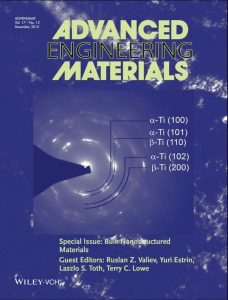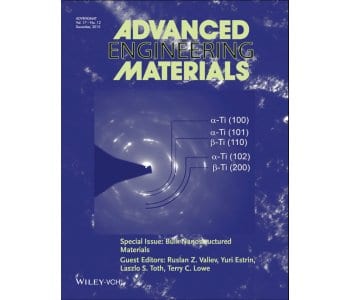 This special issue of Advanced Engineering Materials, guest-edited by Ruslan Z. Valiev, Yuri Estrin, Laszlo S. Toth and Terry C. Lowe, provides a representative survey of the advances in bulk-nanostructured materials and shows the diversity of applications of severe plastic deformation.
This special issue of Advanced Engineering Materials, guest-edited by Ruslan Z. Valiev, Yuri Estrin, Laszlo S. Toth and Terry C. Lowe, provides a representative survey of the advances in bulk-nanostructured materials and shows the diversity of applications of severe plastic deformation.
Although the history of NanoSPD activity dealing with the producing of ultrafine-grained (UFG) materials by severe plastic deformation (SPD) techniques spans about 25 years, recently a trend has emerged to introduce new SPD processing routes and regimes, particularly for fabrication of new UFG metals and alloys with novel properties. These new developments are also within the scope of this special issue.
Exceptional strength is the leading attribute that distinguishes UFG metals from their conventional coarse-grained counterparts. Accordingly, the special issue features a review that focuses on the mechanical properties of UFG materials and addresses the dichotomy between strength and ductility. The subject of nine full papers and one communication is the mechanics of SPD processing.
Transforming the metallurgical state of alloys, including both grain refinement and phase transformations associated with dissolution and precipitation of second phases, is among the most promising applications of SPD. Five full papers and one communication present interesting results on SPD-induced variations of the metallurgical state of Ti–Fe, Al–Zn, Al–Fe, Ti–15Mo β–alloys, and low-alloyed bronzes. New perspectives on SPD-induced synthesis of hybrid materials are also outlined in one paper.
SPD is increasingly being applied to powder consolidation and processing of initially amorphous alloys; one paper reports on textures and microstructures as well as shear strain heterogeneities in the thickness direction in iron powder consolidated by HPT. Another field of SPD applications that has advanced over the recent years is dental implants; one paper provides a report about the state of the art of research and commercial applications of SPD-processed titanium in dentistry.
Selected articles of the special issue can be read for free:
In this Full Paper Y. Beygelzimer, Y. Estrin and R. Kulagin present a new realm of applications of SPD processes, which they believe is no less exciting than the established ones (see also here).
In this Review A. Vinogradov summarizes the most prominent features of the mechanical behavior of UFG metals manufactured by SPD.
In this Full Paper J. M. Cubero-Sesin, M. Arita and Z. Horita attempted a synergistic combination of high-pressure torsion (HPT) and artificial aging in Al-Fe alloys to achieve high strength and high electrical conductivity.

















